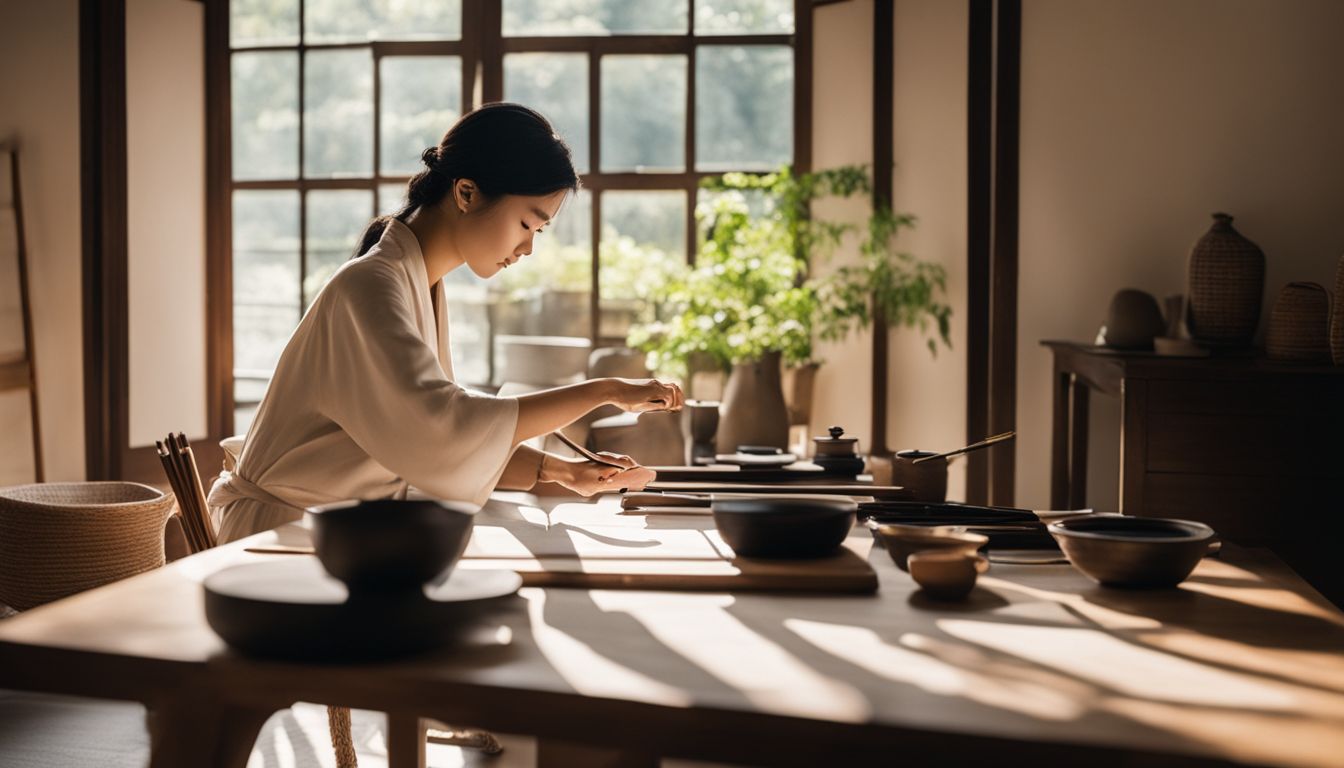Calligraphy is a timeless and elegant art form that combines beauty and precision. Perfecting your craft in calligraphy requires dedication, patience, and the right techniques. Whether you are a beginner or an experienced calligrapher, practicing effectively is key to honing your skills and creating stunning lettering. This article will guide you through essential tools, basic strokes, developing your unique style, effective practice routines, common mistakes, advanced techniques, and incorporating calligraphy into art and design.
Essential Tools for Calligraphy Practice
To commence your calligraphy journey, equipping yourself with the right tools is essential, especially for beginners like you. The list for items you will need is rather small: Pen, Paper and Ink! This hobby is truly wonderful because it doesn’t take you much to start practicing calligraphy.

Beginner Fountain Pen
Mastering Basic Strokes
Now that you’ve familiarized yourself with the essential tools and explored different calligraphy styles, it’s time to roll up your sleeves and start practicing. The foundation of calligraphy lies in mastering the basic strokes, which are the building blocks for creating beautiful letters and words.
Developing Your Unique Style
Experimenting with Different Scripts
Exploring different styles is a fun and enlightening journey for calligraphy beginners. You may discover that you’re drawn to one style in particular, or you may choose to master several styles to expand your repertoire. Regardless of the path you choose, each style offers its own unique beauty and challenges, making your calligraphy journey all the more rewarding.
Incorporating Personal Flourishes
One of the best things about Modern Calligraphy is that it allows you to experiment with different styles and techniques. Try adding flourishes to your letters, or experimenting with different types of lettering, such as brush lettering or pointed pen lettering. The more you practice, the more you’ll develop your own personal style.
Balancing Consistency and Creativity
As your proficiency in calligraphy grows, don’t hesitate to explore more complex layouts and design elements to elevate your calligraphy projects. The art of design adds depth and personality to your calligraphy, transforming it from mere beauty into a visual experience that leaves a lasting impression.
Mastering the art of writing with a rollerball pen: enhance handwriting, calligraphy, and personal style with rollerball pens. Smooth, expressive, and easy to maintain for a refined writing experience.
Effective Practice Routines
Setting Aside Regular Practice Time
To truly excel in calligraphy, it’s essential to set aside regular practice time. Consistency is the cornerstone of achieving polished calligraphy. Your ultimate goal should be the uniformity of letter size, spacing, and style. Regular practice is your steadfast ally in developing the muscle memory required for consistent letterforms.
Using Practice Sheets
Incorporating practice sheets into your daily routine is a wise strategy. These sheets come complete with guidelines tailored to different calligraphy styles, providing a structured and purposeful approach to practicing letterforms, words, and even entire compositions. An exemplar serves as a beacon of inspiration—a sample of well-executed calligraphy in a specific style.
When it comes to calligraphy, practice makes perfect! Write the same letters over and over until it becomes second nature. Need help practicing? Consider a calligraphy pen set which comes with pens and a practice sheet.
Tracking Your Progress
The more you incorporate experimenting into your practice routine, the more you will find out about your flaws and where you are doing exceedingly well. This will aid you in tackling the pain points and you can improve them by working on them.
Practice with purpose: When practicing calligraphy, it is important to have a specific goal in mind. This might be improving your consistency, perfecting a particular stroke, or mastering a new technique. By practicing with purpose, you will be able to track your progress and see tangible improvements.
Common Mistakes and How to Fix Them
Identifying Common Errors
One of the most common mistakes that beginners make is inconsistent letter spacing. This is often caused by not taking the time to plan out the spacing before starting to write. To fix this, try using grid paper to plan out the spacing of your letters before you start writing. This will help you to maintain consistent spacing between each letter and create a more polished look.
Correcting Stroke Issues
Another common mistake is incorrect letter formation. This can be caused by not understanding the basic strokes that make up each letter. To fix this, practice each stroke individually before attempting to write a full letter. You can also find instructional videos online that demonstrate correct letter formation.
Improving Letter Spacing
Poor pen control is another common mistake that beginners make. This can be caused by using the wrong type of pen or holding the pen too tightly. To fix this, experiment with different types of pens to find one that feels comfortable in your hand. You can also practice exercises that focus on pen control, such as writing circles or spirals.
Practice the same letters over and over until it becomes second nature. If you need help practicing consider getting a calligraphy pen set.
By following these tips and practicing consistently, you will be able to improve your calligraphy skills and create beautiful, intricate lettering. Remember, practice makes perfect so don’t be afraid to make mistakes and keep trying!
Advanced Techniques for Experienced Calligraphers
As you gain confidence and proficiency in calligraphy, consider exploring advanced techniques and styles. Brush calligraphy, pointed pen variations, and contemporary calligraphy styles can offer new creative avenues to explore and master.
Incorporating Calligraphy into Art and Design
Creating Calligraphic Art Pieces
Calligraphy is an art form that has been around for centuries. From ancient China to medieval Europe, calligraphy has been used to create beautiful manuscripts, religious texts, and decorative designs. But calligraphy isn’t just for the past – it’s a versatile tool that can be used in modern art and design as well. Whether you’re a graphic designer, an illustrator, or just someone who loves to create, calligraphy can add a unique touch to your work.
Once you’ve mastered the art of calligraphy it’s time to show it to the world! You can write wonderful calligraphy gifts for friends and family on blank stretch canvas, they make wonderful gifts for both birthdays and Christmas – Use these Blank Canvas.
Enhancing Design Projects
As your proficiency in calligraphy grows, don’t hesitate to explore more complex layouts and design elements to elevate your calligraphy projects. The art of design adds depth and personality to your calligraphy, transforming it from mere beauty into a visual experience that leaves a lasting impression.
Combining Calligraphy with Other Media
Use calligraphy to create custom typography. Calligraphy can be used to create unique lettering for logos, book covers, and other designs. By hand lettering your typography, you can create something that is truly one-of-a-kind.
Experiment with different styles of calligraphy. Calligraphy has many different styles, from traditional scripts to modern brush lettering. Try out different styles to find the one that best fits your project.
Combine calligraphy with other art forms. Calligraphy can be combined with illustration, painting, and other art forms to create mixed media pieces. For example, you could create a watercolor painting and then add calligraphy on top of it.
Use calligraphy to create decorative elements. Calligraphy can be used to create borders, frames, and other decorative elements in your designs. These elements can add a touch of elegance and sophistication to your work.
Conclusion
Mastering the art of calligraphy is a journey that requires patience, dedication, and consistent practice. By following the techniques and tips outlined in this article, you can steadily improve your skills and create beautiful, intricate lettering. Remember, practice makes perfect, so don’t be afraid to make mistakes and keep experimenting with different styles and tools. The key is to have fun and enjoy the process of learning and perfecting your craft. With time and effort, you’ll be able to produce stunning calligraphy that showcases your passion and dedication to this timeless art form.
Frequently Asked Questions
How often should I practice calligraphy to see improvement?
Consistency is key in calligraphy. Setting aside specific time each day for practice, even if it’s just 15-30 minutes, can significantly improve your skills over time.
What are the essential tools for a beginner in calligraphy?
Beginners should start with a good quality pen, smooth paper, and high-quality ink. As you progress, you can experiment with different tools and materials.
How can I correct common mistakes in calligraphy?
Identify the errors first, such as inconsistent strokes or poor letter spacing. Practice the specific strokes or letters you struggle with and consider using guidelines to maintain consistency.
What is the best way to develop my unique calligraphy style?
Experiment with different scripts and incorporate personal flourishes. Balance consistency with creativity to find a style that feels natural and unique to you.
How can I track my progress in calligraphy?
Use practice sheets and keep a calligraphy journal. Regularly compare your current work with past pieces to see how much you’ve improved.
Are there advanced techniques for experienced calligraphers?
Yes, experienced calligraphers can explore complex scripts, use advanced tools, and attend workshops or classes to further refine their skills.




Leave a Reply
You must be logged in to post a comment.